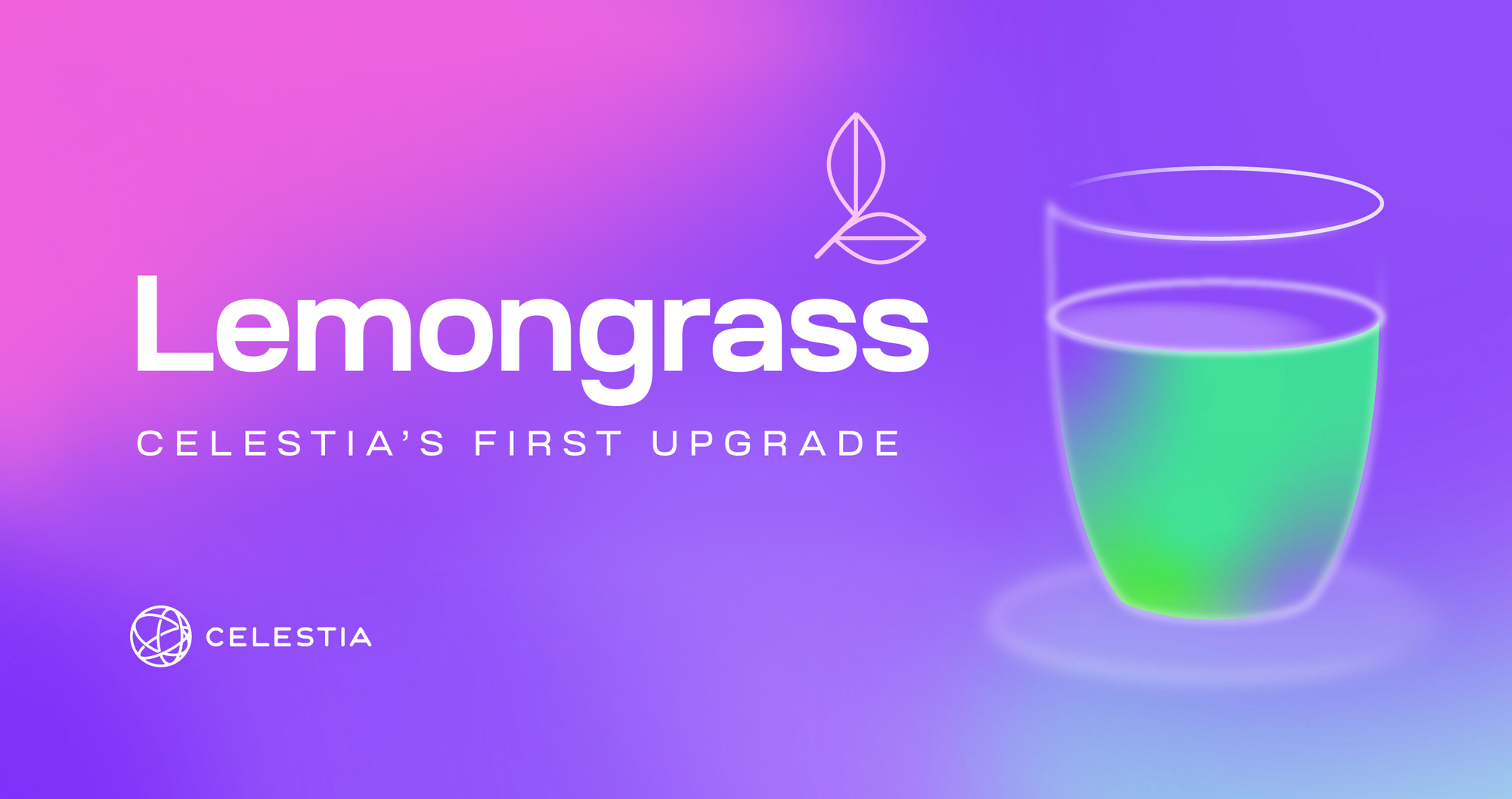Lemongrass: Celestia's first upgrade

A significant milestone is coming up for Celestia, in coordination with its community: The Lemongrass upgrade. This milestone contains many consensus layer changes, such as Interchain Accounts, Packet Forward Middleware, and CIP-10, a mechanism which simplifies future upgrades.
The release of v2.0.0 of celestia-app will be used to activate Lemongrass on Arabica Devnet in August. Upon successful activation and testing, Mocha Testnet is also expected to be upgraded in August. Finally, Celestia Mainnet Beta will have a version release for Lemongrass, which is estimated for early to mid-September. Like all network upgrades, the precise timing and sequence of events will be driven by Celestia's community of developers and researchers to ensure a successful and smooth hardfork activation.
The DA layer is also undergoing technical changes coordinated with the community. These changes include pruning blob data (CIP-4), released in v0.14.1 of celestia-node, and Shwap (CIP-19), a new messaging framework for DA and sampling. Stay tuned for a future blog post covering Shwap.
Now, let’s explore the CIPs in Lemongrass and what they mean for the community.
Changes coming to Celestia
The Lemongrass hardfork covers several CIPs specified in CIP-17. During Celestia Core Developers Call 12, rough consensus to proceed with CIP-17 emerged, moving CIP-17 to Final. The audit by Informal can be found here
The CIPs in Lemongrass include:
- CIP-6: Price enforcement.
- CIP-9: Packet Forward Middleware.
- CIP-10: Coordinated Upgrades.
- CIP-14: Interchain Accounts.
- CIP-20: Disable Blobstream module.
CIP-6: Price Enforcement
CIP-6 brings a mechanism to enforce minimum gas price for transactions on the network. This helps minimize spam, encourages the Celestia network to remain efficient, and thus ensures the cost of using the network is adequately accounted for.
CIP-9: Packet Forward Middleware
CIP-9 brings Packet Forward Middleware (PFM) which is an important change for IBC that enables IBC multi-hop and facilitates forwarding of data packets. This ensures bridging has minimal latency and overhead while reaching intended destinations.
Let’s imagine you have Tia on one chain and you want to transfer it to another chain. Without PFM, you’d need to bridge it back to Celestia and then transfer it to another chain. With PFM, you can do this operation by signing 1 transaction.
CIP-10: Coordinated Upgrades
CIP-10 introduces a new signaling mechanism for upgrading the network, specifically an in-protocol signaling mechanism for validators. Validators use the mechanism to signal readiness for a hardfork upgrade, and when a quorum of 5/6 of network stake is reached, the network migrates to the new version. Post-Lemongrass, Celestia upgrades will use the mechanism outlined in this CIP.
This ensures faster and simpler network upgrade mechanisms for Celestia, a departure from existing mechanisms in CometBFT intended to ensure network stability and minimize downtime for users.
CIP-14: Interchain Accounts
CIP-14 is a long awaited change to the Celestia network which introduces Interchain Accounts, defined by ICS-27, or ICA for short. This allows accounts in the Celestia network to be controlled by accounts on another chain via IBC. This integration will enhance interoperability between Celestia and IBC-enabled chains with ICA in the Cosmos ecosystem.
CIP-20: Disable Blobstream Module
CIP-20 will disable the Blobstream module in Celestia’s consensus layer, which aims to simplify the network architecture and improve performance. The Blobstream module in Celestia's consensus layer is deprecated in favor of zk-light clients developed by the core developer community, like Succinct Labs’ Blobstream X and Risc0’s Blobstream Zero.
This ensures a simpler architecture for all Layer 2s on Ethereum and other settlement layers that want to benefit from Blobstream and Celestia DA for cheaper transactions.
See the Lemongrass hardfork docs for more details.
